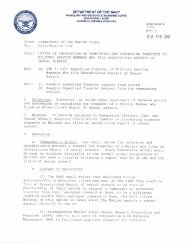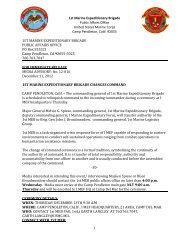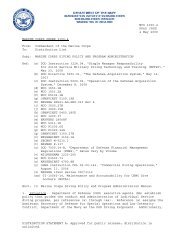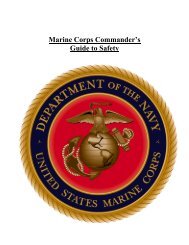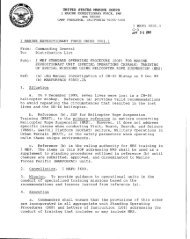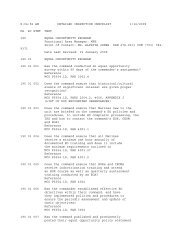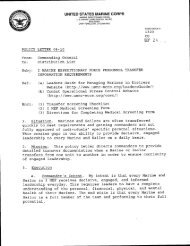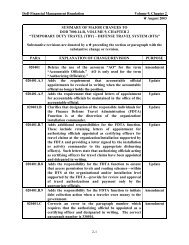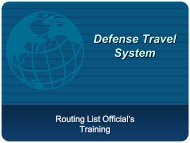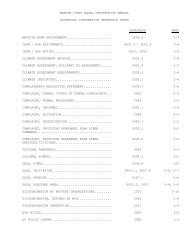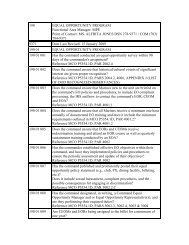constructed travel worksheet instructions for authorization
constructed travel worksheet instructions for authorization
constructed travel worksheet instructions for authorization
You also want an ePaper? Increase the reach of your titles
YUMPU automatically turns print PDFs into web optimized ePapers that Google loves.
07/02/2013<br />
DEFENSE TRAVEL<br />
MANAGEMENT OFFICE<br />
Completing a Constructed Travel Worksheet –<br />
Authorization<br />
I. Overview of Constructed Travel<br />
When triggered, the DTS Constructed Travel pre-audit indicates that a <strong>constructed</strong> <strong>travel</strong> <strong>worksheet</strong><br />
(CTW) may be required. A CTW is not required if your trip meets one of the following conditions:<br />
1. Your local policy identifies your selected mode of transportation as the standard transportation<br />
mode.<br />
2. You will drive your privately-owned automobile or motorcycle (Privately-owned Conveyance (POC))<br />
400 or fewer miles one-way (official mileage per DTOD) on every <strong>travel</strong> segment.* For example:<br />
a. You will drive 800 or fewer miles round-trip on a 1-location TDY<br />
(e.g., PDS TDY location (LOC) = 310 miles; round-trip = 620 miles)<br />
b. You will drive 400 or fewer miles one-way <strong>for</strong> all <strong>travel</strong> segments* of a multi-location TDY<br />
(e.g., PDS LOC1 = 210 miles, LOC1 LOC2 = 75 miles, LOC2 PDS = 145 miles)<br />
If either condition applies, do not complete a CTW. Justify the Constructed Travel pre-audit by<br />
explaining that a CTW is not required.<br />
Consult your AO or DTA if you do not know whether you need to complete a CTW.<br />
* A <strong>travel</strong> segment is any one-way journey:<br />
• From the PDS to a TDY location<br />
• From one TDY location to another TDY location<br />
• From a TDY location to the PDS<br />
II. Traveler Instructions<br />
A CTW is required <strong>for</strong> each <strong>travel</strong> segment over 800 miles round-trip or over 400 miles one-way,<br />
when using a non-standard transportation mode. When a CTW is required, enter a justification in the preaudit<br />
remarks field, complete the <strong>worksheet</strong>, and electronically attach it to your <strong>authorization</strong> using the<br />
Substantiating Records screen.<br />
Your AO will use the CTW to decide whether to authorize full reimbursement <strong>for</strong> your <strong>travel</strong> expenses<br />
or to limit your reimbursement to the <strong>constructed</strong> cost (see below).<br />
Defense Travel Management Office 1
Completing a Constructed Travel Worksheet – Authorization 6/26/2013<br />
Complete the CTW as follows:<br />
1. Enter your Name and all your TDY Locations and Dates of Travel.<br />
2. Calculate the Policy Constructed Transportation Cost. These items are outlined in red, indicating<br />
that they are mandatory.<br />
a. Line A is the cost of the standard transportation mode. If the standard transportation mode<br />
is commercial air, use the following steps to obtain the cost:<br />
i. Use the Travel > Air screen to find flights, using the airports you would have used if<br />
<strong>travel</strong>ing by commercial air.<br />
ii. Select the GSA Contract Airfare tab; do not use any other tab. If the GSA Contract<br />
Airfare tab does not display any flights, ask your CTO <strong>for</strong> the cost of the least<br />
expensive, unrestricted economy/coach class airfare.<br />
iii. Select the Price radio button to sort the results by cost, lowest cost first. Note that<br />
DTS posts the one-way cost; you’ll have to double it to obtain the round-trip cost.<br />
iv. Electronically attach to the <strong>authorization</strong> a copy of the DTS screen or CTO quote<br />
showing the total cost, including taxes and fees.<br />
Note: If local policy identifies the standard transportation mode as bus or rail, use the actual ticket<br />
cost, including taxes and fees instead.<br />
b. Line B is the standard CTO transaction fee, if any. If you are unsure what your CTO charges,<br />
consult your DTA or AO.<br />
c. The Total <strong>constructed</strong> cost (sum of Lines A and B) will be completed <strong>for</strong> you.<br />
3. The Additional Comments text field is an optional field unless required by local policy or if you will be<br />
using a POC to transport passengers on TDY <strong>travel</strong>. If transporting passengers, include:<br />
a. The number of passengers and their names.<br />
b. The policy <strong>constructed</strong> transportation cost <strong>for</strong> the additional passengers.<br />
4. When the CTW is complete:<br />
a. Select Save at the bottom of the completed <strong>worksheet</strong> to save the file to your computer.<br />
b. Follow the usual DTS process <strong>for</strong> electronically attaching the document to your <strong>authorization</strong>.<br />
c. Mark the document as a <strong>constructed</strong> <strong>travel</strong> <strong>worksheet</strong> by checking the CTW checkbox on the<br />
Substantiating Records screen.<br />
d. Justify the Constructed Travel pre-audit by explaining why you are requesting to <strong>travel</strong> by a<br />
non-standard mode.<br />
Defense Travel Management Office 2
Completing a Constructed Travel Worksheet – Authorization 6/26/2013<br />
III. AO Instructions<br />
When you stamp the document APPROVED, the Cost Comparison screen opens. This screen helps<br />
you decide whether to limit the <strong>travel</strong>er’s reimbursement to the <strong>constructed</strong> cost or to allow full<br />
reimbursement <strong>for</strong> <strong>travel</strong>. When the Cost Comparison screen opens:<br />
1. Open the CTW from the DTS Substantiating Records screen.<br />
2. Enter the amount on Line A of the CTW into the Transportation Expenses block.<br />
3. Enter the amount on Line B of the CTW into the Expense Cost Factors block. DTS automatically<br />
calculates the Total Allowed Cost.<br />
4. Compare the Preferred Trip Total to the Total Allowed Cost. Although the relative costs are a<br />
primary consideration, you may consider other factors such as:<br />
a. Will authorizing the <strong>travel</strong>er’s requested transportation mode incur additional per diem<br />
b. Will there be costs <strong>for</strong> transporting equipment<br />
c. Will multiple <strong>travel</strong>ers be able to share transportation costs<br />
d. What is the effect of <strong>travel</strong> on productive time<br />
e. What is the potential <strong>for</strong> weather delays<br />
Approving with no limited reimbursement:<br />
If <strong>travel</strong> by a non-standard mode is the best way <strong>for</strong> the <strong>travel</strong>er to execute this trip, do not check<br />
the Approve as Limited checkbox. Select Approve and Continue to conclude the <strong>authorization</strong> process.<br />
Note: If the <strong>travel</strong>er requested to use a rental vehicle to <strong>travel</strong> to and from the TDY location, do not<br />
authorize the request as limited. If rental vehicle use is not the best way to per<strong>for</strong>m this <strong>travel</strong>, return the<br />
<strong>authorization</strong> to the <strong>travel</strong>er with <strong>instructions</strong> to select a different transportation mode.<br />
Approving with limited reimbursement:<br />
If <strong>travel</strong> by a non-standard mode is not the best way <strong>for</strong> the <strong>travel</strong>er to execute this trip, you may<br />
still authorize its use, but limit the <strong>travel</strong>er’s reimbursement to the <strong>constructed</strong> cost. To do so:<br />
1. Verify that the Total Allowed Cost is less than the Preferred Trip Total.<br />
2. Check the Approve as Limited box.<br />
3. Select Approve and Continue to conclude the <strong>authorization</strong> process.<br />
See Caution, next page.<br />
Defense Travel Management Office 3
Completing a Constructed Travel Worksheet – Authorization 6/26/2013<br />
Caution:<br />
When limiting a <strong>travel</strong>er’s transportation reimbursement, you must also ensure the <strong>travel</strong>er’s<br />
document does not include transportation-related expenses that exceed the allowed reimbursement level.<br />
The most common scenario – <strong>travel</strong> by POC – limits the <strong>travel</strong>er’s reimbursement to the following items:<br />
Type<br />
Parking cost claim<br />
Cost of tolls<br />
Type<br />
POC mileage<br />
Selection on Non-Mileage Expense Screen<br />
Parking-TDY/TAD<br />
Tolls (highway bridge etc)<br />
Selection on Mileage Expense Screen<br />
Pvt Auto-TDY/TAD or Pvt Motorcycle-TDY/TAD<br />
Defense Travel Management Office 4



